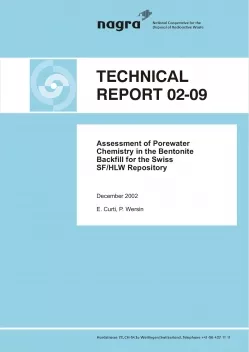
Technical Report NTB 02-09
Assessment of Porewater Chemistry in the Betonite Backfill for the Swiss SF/HLW Repository
The porewater chemistry in the bentonite backfill will strongly affect the mobility of radionuclides via sorption and solubility equilibria. The aim of this study was to derive a reference bentonite porewater composition for the Swiss high-level waste repository and to estimate compositional uncertainties. Special emphasis was put on the evaluation of acid-base buffering mechanisms and the related variables pH and pCO2.
Recent experimental data at high solid/water ratios are analysed by means of a classical aqueous solution - mineral equilibrium model using two distinct sets of constants for sorption reactions. An optimised thermodynamic model is then applied to repository conditions. A sensitivity analysis is then performed to identify critical geochemical parameters and to quantify their effect on porewater chemistry. The evolution of porewater chemistry in time is studied with the help of two alternative models, one based on water-exchange cycles, the other relying on diffusion. For the derivation of the reference porewater, a redox model based on the equilibrium between magnetite and dissolved Fe2+ is integrated in the clay/water reaction model. Uncertainties related to pH, Eh, and major anion concentrations (Cl-, SO4 2-, CO3 2-) are evaluated. Finally, available trace element data are presented.
Two limiting bentonite porewater compositions with pCO2 fixed at 10-3.5 and 10-1.5 bar have been modelled, which define the pH and Eh boundaries specified below. A third, intermediate composition, calculated with pCO2 fixed at 10-2.2 bar, is considered to reflect the most probable repository conditions, and is thus defined as reference bentonite porewater. The resulting three waters are Na-(Ca-Mg-)-Cl-(SO4) dominated and have a ionic strength of about 0.3 M.
The main results of this modelling study can be summarised as follows:
- The large uncertainty related to the pCO2 in equilibrium with the groundwater permeating the host-rock has a significant effect on the pH of the bentonite porewater, resulting in a relatively wide range (from 6.9 to 7.8).
- Redox conditions are predicted to be reducing at all assumed pCO2, resulting in oxidation potentials between -280 and -130 mV.
- The bentonite porewater chemistry is expected to remain stable over very long times, largely because of its similarity to the surrounding Opalinus Clay water.
Conventional thermodynamic models, as applied in this study and in other safety assessments, do not consider some complex physico-chemical processes occurring specifically in highly compacted, swelling clays (e.g. osmosis, reduction of external porosity). Further experimental investigations and new methodologies need to be developed to understand such processes and to integrate them in geochemical models. Nevertheless, we performed additional calculations with a refined model to account for the effects of anion exclusion and porosity reduction. The results indicate that porewater composition is quite insensitive to such processes. This makes us confident that the derived reference porewater composition is a reasonable estimate and is suitable for performance assessment.
